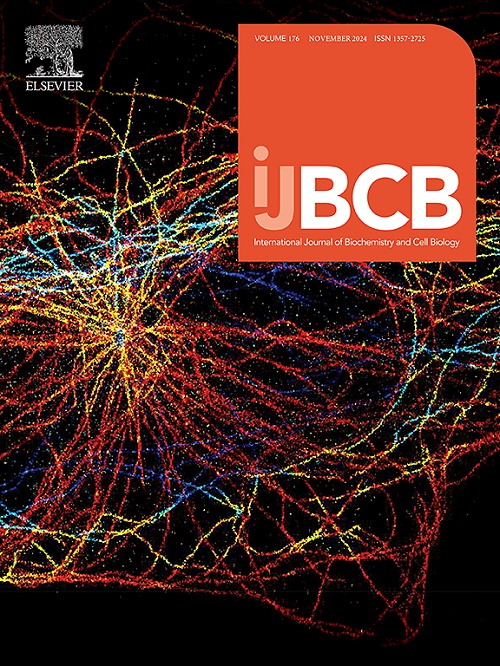TFAP2C/FLT3 axis reduces ferroptosis in breast cancer cells by inhibiting mitochondrial autophagy
IF 2.8
3区 生物学
Q2 BIOCHEMISTRY & MOLECULAR BIOLOGY
International Journal of Biochemistry & Cell Biology
Pub Date : 2024-11-12
DOI:10.1016/j.biocel.2024.106691
引用次数: 0
Abstract
Background
FMS-like tyrosine kinase 3 (FLT3), a key target protein for treating acute myeloid leukemia, has recently been found to be closely related to ferroptosis in breast cancer (BC). However, the mechanism by which FLT3 regulates ferroptosis in BC remains unknown. Whether this regulatory relationship can be exploited for BC treatment needs further exploration.
Methods
This study combined analysis from The Cancer Genome Atlas database with immunohistochemistry/quantitative reverse transcription-PCR/Western blot experiments to verify the expression of FLT3 in BC. FLT3 knockdown/overexpression plasmids were used in conjunction with mitochondrial autophagy inducers to treat BC cells, analyzing the effects of FLT3 on autophagy and ferroptosis. Key transcription factors for FLT3 were determined through predictions from the KnockTF database and dual luciferase/chromatin immunoprecipitation experiments, further analyzing the impact of this regulatory axis on autophagy and ferroptosis in BC cells.
Results
FLT3 was significantly overexpressed in BC tissues and cells. Overexpression of FLT3 could inhibit autophagy and ferroptosis in BC cells, a regulation that was restored upon the addition of mitochondrial autophagy inducers. Additionally, transcription factor AP-2 gamma (TFAP2C) could mediate the transcriptional activation of FLT3, further inhibiting ferroptosis induced by mitochondrial autophagy.
Conclusion
The TFAP2C/FLT3 axis reduced ferroptosis in BC cells by inhibiting mitochondrial autophagy. These research findings elucidated the mechanism by which FLT3 regulated ferroptosis in BC and provided potential targets for BC treatment.
TFAP2C/FLT3轴通过抑制线粒体自噬减少乳腺癌细胞的铁变态反应
背景:FMS样酪氨酸激酶3(FLT3)是治疗急性髓性白血病的关键靶蛋白,最近发现它与乳腺癌(BC)中的铁突变密切相关。然而,FLT3 在 BC 中调控铁突变的机制仍不清楚。能否利用这种调控关系来治疗乳腺癌还需要进一步探索:本研究结合癌症基因组图谱数据库分析和免疫组化/定量反转录-PCR/Western印迹实验,验证了FLT3在BC中的表达。将FLT3基因敲除/外表达质粒与线粒体自噬诱导剂一起用于治疗BC细胞,分析FLT3对自噬和铁变态反应的影响。通过KnockTF数据库的预测和双荧光素酶/染色质免疫沉淀实验确定了FLT3的关键转录因子,进一步分析了这一调控轴对BC细胞自噬和铁突变的影响:结果:FLT3在BC组织和细胞中明显过表达。结果:FLT3在BC组织和细胞中明显过表达,过表达可抑制BC细胞中的自噬和铁蛋白沉降,加入线粒体自噬诱导剂后可恢复这种调控。此外,转录因子AP-2 gamma(TFAP2C)可介导FLT3的转录激活,进一步抑制线粒体自噬诱导的铁变态反应:结论:TFAP2C/FLT3轴通过抑制线粒体自噬减少了BC细胞的铁变态反应。这些研究结果阐明了FLT3调控BC细胞铁凋亡的机制,并为BC治疗提供了潜在靶点。
本文章由计算机程序翻译,如有差异,请以英文原文为准。
求助全文
约1分钟内获得全文
求助全文
来源期刊
CiteScore
8.10
自引率
0.00%
发文量
124
审稿时长
19 days
期刊介绍:
IJBCB publishes original research articles, invited reviews and in-focus articles in all areas of cell and molecular biology and biomedical research.
Topics of interest include, but are not limited to:
-Mechanistic studies of cells, cell organelles, sub-cellular molecular pathways and metabolism
-Novel insights into disease pathogenesis
-Nanotechnology with implication to biological and medical processes
-Genomics and bioinformatics

 求助内容:
求助内容: 应助结果提醒方式:
应助结果提醒方式:


